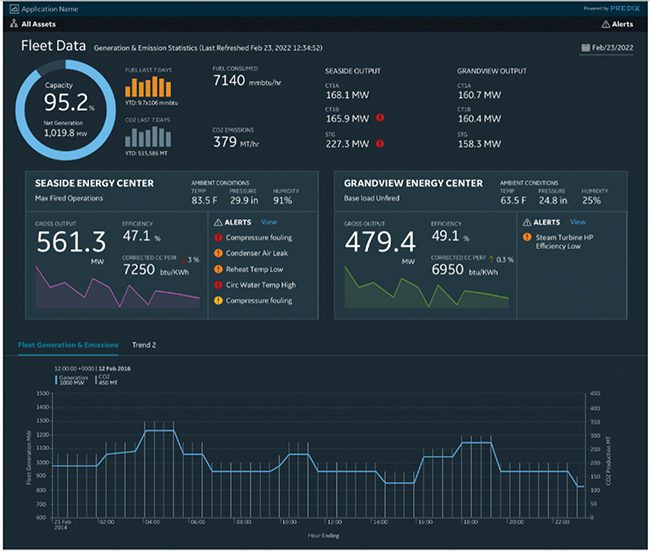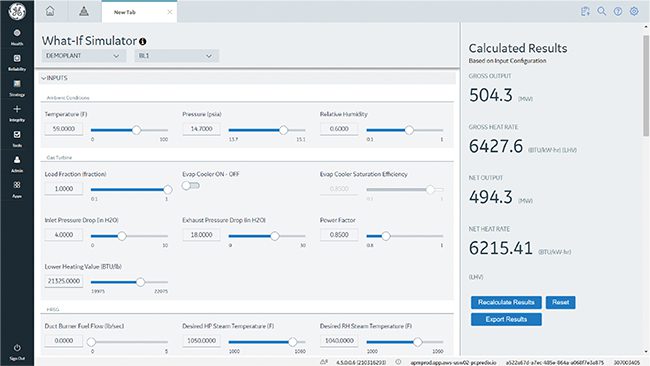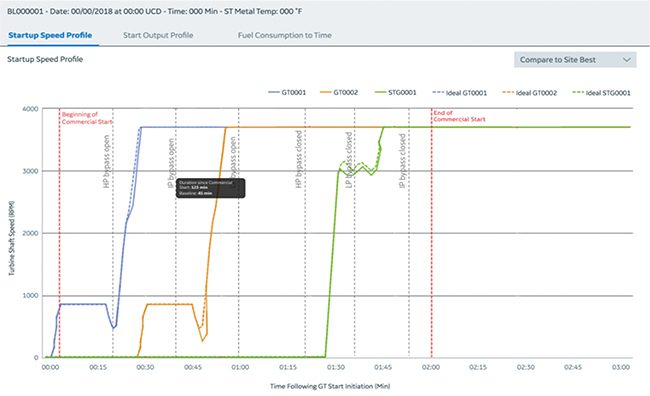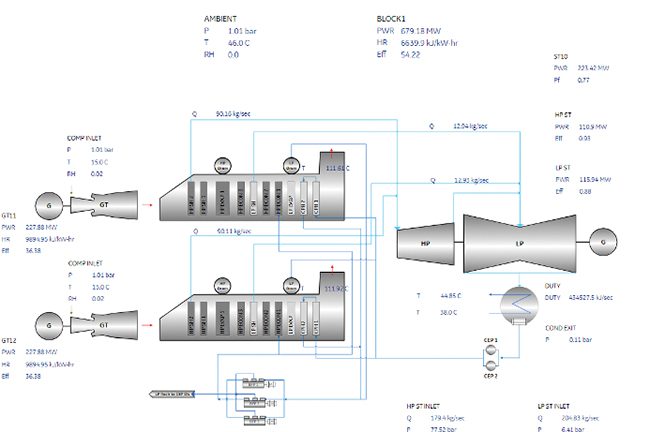Reduce Plant Fuel Use, Emissions, and Operating Cost with Performance Models and Predictive Maintenance
Thermal power generation has to adapt new methods to thrive as renewables transform dispatch. Now used more often as a bridge source of power rather than the main source of power, many fossil fuel plants operate at levels far below their original design. Variability demands flexibility, and as plant operators are forced to cycle more, reaching optimum efficiency and reliability measures with technology is essential for economic viability.
In response to fluctuating fuel prices and escalating operating costs, plant operations teams must act with greater speed and efficiency to maintain assets’ economic expectation. On top of these expectations, power generators are under increased pressure from regulatory bodies, investors, and consumers to lower plant carbon emissions.
Static and internal models to track performance and emissions often are based on calculations for running at baseload or at the design entitlement. If a plant was designed to output 500 MW, all the assets were maintained to keep it at that level. The constant variations in today’s power market can cause accelerated asset degradation, greater fuel consumption, and increased carbon output—all leading to increased costs, and risk of critical asset failures and downtime.
 |
|
1. This is an illustration of a Thermal Performance Dashboard. A consolidated dashboard provides real-time alerts with diagnostic insights, along with the impact on plant capability to support data-based decision-making. Courtesy: GE Digital |
There’s a clear need for integrated asset monitoring and performance solutions, so asset and plant data feeds maintenance and performance recommendations seamlessly and to scale (Figure 1). Software that combines performance intelligence and asset performance management, or APM, reliability is important so plant personnel can gain visibility to equipment health, degradation, and reliability issues to improve asset performance.
 |
|
2. The “what if” simulator is an interactive thermal model interface to evaluate the plant performance impacts for specific scenarios of interest. Courtesy: GE Digital |
The solution doesn’t stop there, however. For plant teams to know exactly what to do with the incoming data, the technology is designed to empower teams with recommendations, including “what if” and economic impact scenario modeling (Figure 2).
What type of return on investment (ROI) can a power plant anticipate with a thermal monitoring advisory solution with APM? That depends on the operating profile and size of the plant, but one recent use case performed by GE Digital showed that the annual benefit at a 600-MW plant was $360,000 in reduced fuel cost, with a reduction of 0.5% in heat rate, and an additional $50,000 or more in regained plant support productivity.
How Performance and Reliability Analytics Work Better Together
Plant engineers are contending with overlapping challenges: a lack of visibility of equipment degradation, dynamic operating profiles that make knowing when and where to make improvements difficult, and outdated modeling that isn’t providing accurate data. They need to know exactly when and where to perform equipment improvements to reduce heat rate, save on fuel, reduce emissions, and meet demand obligations.
 |
|
3. Flexibility Performance Monitoring provides insights for start fuel, start time, ramp rate, and minimum load to improve plant flexibility and operational performance. Courtesy: GE Digital |
The case study showed how GE Digital’s Performance Intelligence (PI) software accurately detected performance issues, and offered recommended actions at any part of the operating range, not just baseload range. Performance Intelligence’s physics-based modeling system is customized to the plant equipment, system design, and dispatch portfolio (Figure 3). The insights delivered help plant personnel understand exactly how equipment is being affected by a new problem or ongoing degradation—and whether it’s something that needs immediate attention.
 |
|
4. The software solution is built on digital twin models customized to plant and equipment designs, and the plant dispatch profile. Courtesy: GE Digital |
APM Reliability works in concert by providing early detection of emerging issues for industrial assets by utilizing machine learning (ML) algorithms to create models around expected asset behavior for these operation conditions. It includes time-to-action forecasting to predict the actual malfunction timeframe to allow accurate maintenance prioritization and scheduling. It includes an online unsupervised ML capability to automatically adapt model parameters and an easy-to-use interface for supervised model training. Its predictive analytics are based on more than 340 digital twins (Figure 4) of both GE and non-GE equipment.
Power plant operators can utilize the software to form a holistic solution to achieve optimum plant performance and reduce unplanned outages. For instance, if Performance Intelligence identifies that cleaning a condenser could recover megawatts of power generation, plant personnel can look at what other equipment needs preventive maintenance, and in what timeframe based on APM Reliability. With insights from each solution, engineers can choose the most opportune time to conduct a planned shutdown to perform prioritized maintenance with the least economic downside.
Economic and Environmental Impact of Performance Recommendations
For energy companies participating in regional merchant markets, such as the Electric Reliability Council of Texas (ERCOT), the economic impact can be great. Performance recommendations can help plants produce more megawatts at peak fire at a time when they’re getting peak power prices. Conversely, one unplanned outage during peak season can ruin a whole financial year. Using this software, operators can also avoid downtime and production loss during peak season, when it is needed most.
Additionally, the PI software incorporates Carbon Reduction Advice (CRA) and Carbon Data Insights (CDI), which are designed to support emissions reduction in thermal generation plants. The CRA capability offers actionable recommendations to improve equipment degradation issues that have a negative impact on fuel consumption and carbon emissions. To illustrate, the software may recommend the optimal timing for an offline water wash or inlet filter cleaning to ensure equipment runs more efficiently, burns less fuel, and produces fewer emissions.
CDI allows plant operators to report daily real-time production and cumulative calculations of their emissions. The analytics use actual fuel data and plant configuration, enabling an accurate calculation of CO 2 tonnage versus traditional statistical estimations. As regulations around plant emissions strengthen, operators can identify mechanical issues that are increasing fuel use and emissions and fix them sooner, avoiding potential penalties and accelerating their own carbon abatement goals.
Real Fuel, Emissions, and Cost-Saving Results from Users
Several users piloting PI with APM Reliability experienced productivity and cost benefits. Independent research firm Verdantix found that SPE, Algeria’s national power generation organization, reduced major incidents by up to 40%, saved more than $20 million in performance and operations costs, and increased availability by up to 6% on an installed base of 15 GW using software applications covering operations performance, plant reliability, and asset maintenance. Verdantix also noted that organizations with solely reactive and preventative maintenance strategies struggle to reach availability rates above 85%.
Another operator was able to identify excessive baseload degradation at part load at a combined cycle plant. With PI, plant personnel discovered the root cause was gas turbine fouling and combustion tuning, and corrected it, recovering heat rate and improving output.
Software Can Eliminate Data Gaps, Help Achieve Optimum Plant Performance
The reality is that many fossil fuel plants can’t operate as they were intended in today’s world. Power generators need to produce reliable power when it’s most in demand, and they need to do it in a way that’s as fuel-efficient as possible to meet the energy transition goals.
As more renewable energy is available on the grid, thermal plants must manage cycling. Performance and maintenance models can play a pivotal role in this process, helping plant operations teams find problem areas at part load and allowing them to peak fire without risk of incident.
—Janet Webb and Thomas Lowisz are senior product managers at GE Digital.